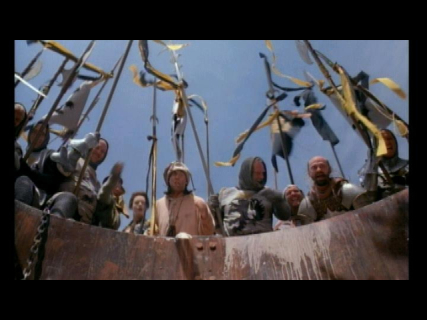Pillarbox
Pillarbox
With the emergence of HDTVs, a common DAR related consideration is fitting a 4:3 (Fullscreen) image on a 16:9 (Widescreen) display. Just as borders must be added to the top and bottom of the frame when its AR is wider than the display, borders can be added to the sides of a 4:3 frame to fit it to a 16:9 TV. These borders are called a Pillarbox. Although this can be done by the TV itself, in the case of sources that are natively widescreen (including HDTV broadcasts) the pillarbox will actually be encoded in the video. This is also done with some widescreen movies that have an AR narrower than 16:9 (typically 1.66:1 movies from Europe).

Above is a frame from a 1.66:1 AR movie encoded to Widescreen for a NTSC DVD. Notice the borders on each side of the image, and no letterbox. Below is the same frame stretched to fit a 16:9 display. Notice that there are still borders on the side. The alternative would be to stretch it further horizontally and crop the top and bottom to 480 pixels, but this could result in loss of important details on some movies. It would, however fill the entire screen with no letterbox or pillarbox.

Below is the same frame squeezed into a 4:3 frame. In addition, displaying 4:3 video on a 16:9 display, like a HDTV, always requires pillarboxing or zooming if you want to avoid any distortion from stretching the image.

Related Guides
Resizing DVD-Video To Square Pixels
Digital Video Fundamentals - Resolution and Aspect Ratio
Related Hardware
16:9 HDTVs

